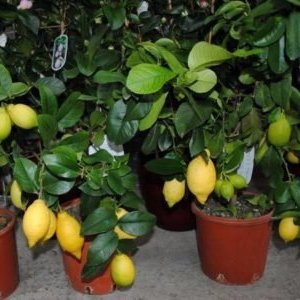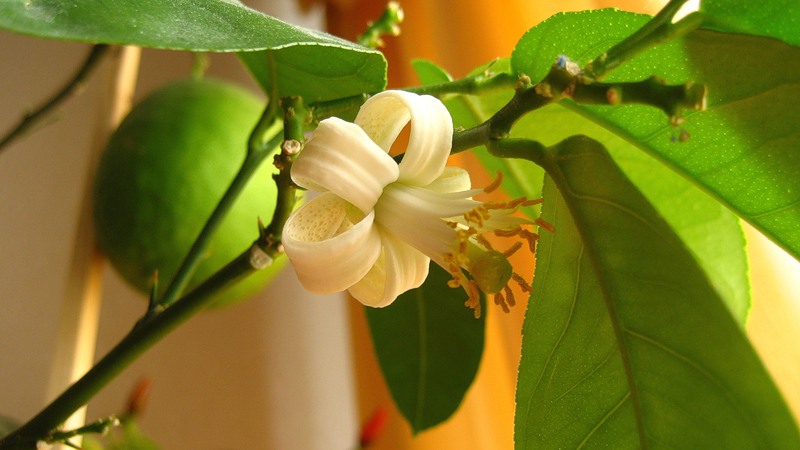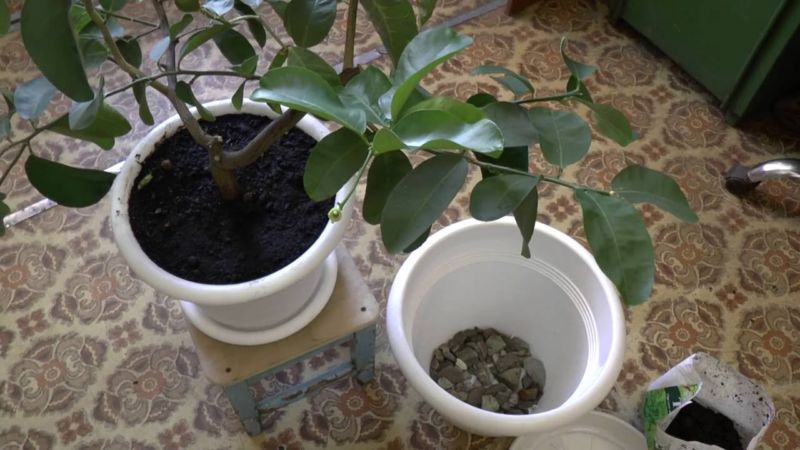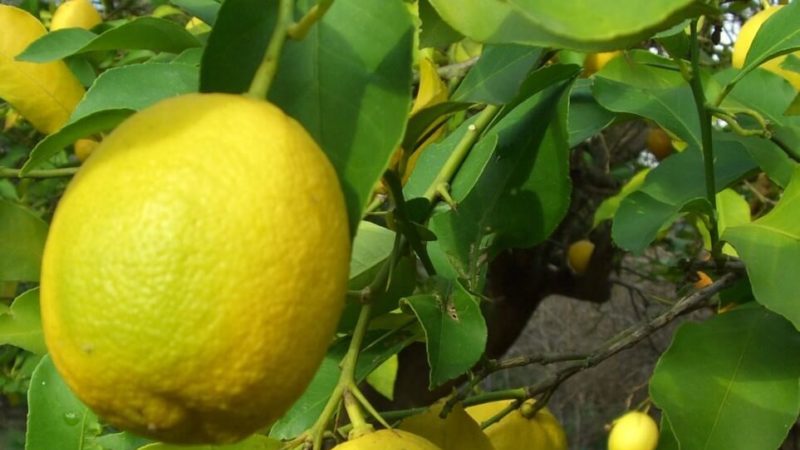Instructions for the care of Pavlovsk lemon at home
Growing lemons at home is a fun activity that makes you feel like a real gardener. With the right variety and care, the plant will bloom and bear fruit even in a pot. At the same time, it is not necessary to have a separate room equipped with devices to create the necessary conditions. The lemon tree can be grown on a windowsill in your home.
The Pavlovsky lemon is the most popular among citrus growers. This is one of the oldest varieties grown on windowsills in our country. It is characterized by compactness, stable and long-term fruiting, ease of crown formation. Read more about growing and caring for Pavlovsky lemon at home.
The content of the article
General description of the variety
Pavlovsky lemon is one of the oldest varieties brought to Russia... These plants may differ slightly in some characteristics. Indeed, over the long years of growing them at home, they have been repeatedly selected.
Twigs of this lemon Ivan Semenovich Karachistov brought his relative Elagin to the city of Pavlov for the first time from Turkey. This happened in the 60s. XIX century.
Elagin rooted the cuttings, grew lemon trees from them and began to distribute the twigs to friends and acquaintances. Soon the exotic plant spread not only across Pavlov, but throughout Russia. The name Pavlovsky lemon was given in honor of the city to which it was brought.
In 1937, on the outskirts of Pavlov, a kennel with lemons was set up. Thanks to the efforts of Soviet breeders, it was possible to achieve long-term fruiting of the variety in conditions of a lack of light and to obtain a pleasant taste of the fruit.
Main characteristics
Pavlovsky lemon is one of the most popular home-grown varieties. He is not tall and feels good in the apartment.
Description of Pavlovsk Lemon:
- Crown. Pavlovsky lemon is more a bush than a tree. Its height reaches 0.8-1.5 m. It usually has 2 to 4 trunks. The branches are strong, not very thick, drooping. Young shoots are smooth and green, old branches are greyish and cracked. The plant has long thorns. The crown is rounded. Its maximum diameter reaches 1 m.
- Leaves. Large, bright green with a glossy sheen. In Pavlovsky lemon, leaf plates are oval, round, ovoid and elongated. The maximum width of an adult leaf plate reaches 8 cm, and its length is 15 cm. The petioles are shortened. The life cycle of one leaf is 3 years.
- Bloom. In most cases, it is observed in September and March. Inflorescences consist of 2-6 flowers of white or light purple hue. The diameter of one flower reaches 2-3 cm. Of all the blossoming buds, no more than 17% of the ovaries remain on the plant. The first flowering is observed 3-4 years after planting. If the lemon blooms earlier, the buds are cut off.

- Fruiting. Comes 3-4 years after planting. From the formation of ovaries to ripening of the fruit, it takes from 9 to 12 months. One young plant rarely produces more than 12 lemons per season. The older the shrub, the more abundantly it bears fruit. On a 15-year-old lemon, up to 50 fruits can be set per year.
- Fruit. Large, weighing from 180 to 500 g and about 10 cm long. The shape is oval, with a sharp nose.The peel is smooth, pale yellow. If you overexpose the fruit on the bush, it will brighten and become coarser. The crust thickness is 5 mm. The pulp is juicy with a sour, slightly sweetish taste. One fruit contains an average of 7 seeds.
- Transportability. High. The dense skin protects the fruit from damage.
Features:
Pavlovsky lemon is not distinguished by strong immunity, resistance to drought and cold snaps. It is rarely grown in a greenhouse or open field. This variety is commonly used as a houseplant.
The main feature of the variety is its compactness. The lemon is easy to form, has a nice round shape, and develops into a bush rather than a tree.
The plant tolerates indoor conditions well. It does not get sick with a lack of lighting and bears fruit all year round. Moreover, he needs a full wintering.
This is one of the few lemons that can actually be grown from a seed, but in this case fruiting occurs much later.
Note! Over the years, Pavlovsky lemon has been subjected to natural and artificial selection more than once. Therefore, the plants of this variety often differ not only in the shape of the leaves, but also in the indicators of resistance.
Growing in a natural environment and at home
Pavlovsky lemon in our country is grown mainly as a houseplant. In the Caucasus and in countries with a topical climate, this variety is not cultivated on an industrial scale due to its low yield.
In greenhouses and greenhouses, the plant does not exceed 1.5 m in height. In a pot on the windowsill, the average height of the bush reaches 0.8 m, often the lemon turns out to be more compact.
The plant requires regular care. Mistakes in its cultivation lead to leaf fall and lack of fruiting.
Advantages and disadvantages of the variety
Pavlovsky lemon has many advantages. Among them:
- the ability to grow with a lack of light;
- large-fruited;
- self-pollination;
- high taste characteristics of fruits;
- compactness of the bush;
- ease of formation;
- year-round fruiting;
- early fruiting;
- possibility breeding in a generative way.
The variety also has disadvantages:
- lack of immunity to fungal and viral infections;
- lack of resistance to cold snaps;
- low productivity.
Planting and breeding

Pavlovsk lemon is propagated by generative and vegetative methods.
In the first case, reproduction occurs by seeds. More hardy plants are obtained from such planting material, which develop quickly and form correctly. Often they are beautifully shaped even without regular haircuts and shaping.
The disadvantage of this method is that seed-grown lemon begins to bear fruit later (after 5-7 years). In this case, the shrub does not necessarily inherit the characteristics of the plant whose fruits were used. In this case, most likely, it will turn out exactly Pavlovsky lemon, and not wild, but its fruits will be more sour and smaller.
With the vegetative method, lemon is propagated by cuttings. This option allows you to get a harvest as soon as possible (after 3-4 years). The stalk will bloom already 2 years after rooting.
Lemons grown from cuttings will produce large fruits with good tasting qualities. At the same time, the shrub is less resistant to negative environmental factors than specimens obtained from seed.
In the case of Pavlovsky lemon, vaccination is optional. It is done only if the tree seed-grown, refuses to bear fruit even 7 years after planting.
Note! Reproduction of Pavlovsky lemon is also possible through air layers. However, this method is rarely used due to the difficulty of obtaining planting material.
In both cases, preparation of containers and soil for lemons is required.The seeds are first sown in a common container, and after the formation of 2 leaves, they are dived into separate containers with a diameter of 5-8 cm.The cuttings are immediately rooted in a separate container with a diameter of 5-8 cm.
For lemon, get a special soil for citrus fruits or prepare a soil mixture yourself. In the second case, mix 2 parts of garden soil, rotted (preferably horse) manure and humus with 1 part of sand. Add 1 tbsp to a bucket of the resulting mixture. ash, 30 g of superphosphate and 20 g of potash fertilizer. This mixture is used to further grow lemons.
Drainage is also needed. Usually they use broken ceramics or bricks, expanded clay, fine gravel.
The soil, containers and drainage are disinfected. This is done using high temperatures (poured with boiling water, ignited in the oven) or disinfecting solutions (potassium permanganate, 1% copper sulfate).
Seeds
Seed material is collected from ripe Pavlovsk lemon fruits of the correct shape, without rot and traces of disease. The bones themselves should be of a uniform light shade, dense, without spots or damage.
The collected planting material is prepared:
- Germination test. The seeds are soaked in salted water. Seeds that float to the surface are not suitable for planting. Specimens that have sunk to the bottom are used.
- Disinfection. The seeds are soaked for 30-60 minutes. in "Fitosporin", a light pink solution of potassium permanganate or hydrogen peroxide.
- Growth stimulation. The planting material is soaked for a day in a growth stimulator. Use purchased products ("Epin") or folk recipes (aloe juice, diluted in half with water).
It is recommended to sow more seeds than needed. Not all of them will sprout and take root after a pick.
It is interesting! Some citrus growers free the seeds from the tough shell before planting. This is done carefully so as not to damage the cotyledons. This procedure accelerates seed germination.
After preparation, start sowing:
- A 1 cm drainage layer is poured onto the bottom of the container. The rest of the volume is filled with soil. The soil is watered with warm water.
- The seeds are sown to a depth of 1 cm at a distance of 3-5 cm from each other and sprinkled with earth.
- The container with crops is covered with foil or transparent plastic and removed to a place with a temperature of + 24 ... + 25 ° C.
- Before the first shoots appear, the soil is regularly moistened, and the crops are aired, opening the greenhouse daily for 15-30 minutes.
- When the seeds germinate, they moisten not only the soil, but also the seedlings. The duration of airing is gradually increased.
- When 2 real leaves appear, lemons dive into individual containers filled with soil and drainage. The seedlings are not covered with foil.
Cuttings
To obtain cuttings, choose a healthy tree that has already borne fruit. The branch from which the planting material will be cut should be no older than a year, have a semi-lignified, green and elastic bark.
8-10 cm recede from the edge of the selected branch and cut at an angle. At least 2-3 live buds should remain on the pruning. The leaves at the bottom of the cutting are cut off. The upper leaves are cut in half.
The shank is immersed first for 30 minutes. in a light pink solution of potassium permanganate, and then for 1 day in a root stimulator ("Kornevin").
Drainage is poured at the bottom of the container, the rest of the volume is filled with soil. The stalk is stuck into the soil 2-3 cm so that it can stand even without support. The lemon is covered with a bag or cut bottle.
Every day, the soil is watered, and the lemon is sprayed with warm water. It is important to open the greenhouse for airing every day for 15-30 minutes.
The rooting of the seedling will be evidenced by awakened buds with emerging shoots. After that, the duration of airing is gradually increased, and then the greenhouse is completely removed. The lemon is transplanted into a new larger pot when its roots fill the previous container.
Growing technology
Pavlovsky lemon is picky about care.When growing it, it is important to maintain the optimal temperature in the room, ensure proper watering and timely apply feeding... Otherwise, the plant will not bloom and bear fruit, and at worst it will simply die.
Optimal conditions

For a lemon to feel good at home, it is important that the room meets the basic requirements:
- Temperature. In summer, spring and autumn, the optimum daytime temperature ranges from + 19 ... + 26 ° C. In winter, the indicators should not exceed + 21 ° C. To bring the lemon to rest, the temperature in winter is lowered to + 10 ... + 15 ° C. The plant does not tolerate sudden changes in temperature, therefore, before it is brought into a colder or warmer room, the pot is brought out to new conditions every day, gradually increasing the time spent there. Draft is also destructive for culture.
- Humidity is maintained within 70-75%. In the hot season, the bush is sprayed from a spray bottle in the morning and in the evening; in the warm season, one spraying per day is enough. In winter, if the lemon is in a heated room, a humidifier or containers of water are placed next to it.
- Lighting. For normal fruiting and flowering, citrus fruits must receive a sufficient amount of light, but direct sunlight is also destructive for them. In spring, summer and autumn, the plant is placed on the eastern, southern or western windowsill, closing the window with a translucent curtain during maximum solar activity. If the lemon bush is dormant in winter, it does not need additional lighting. If the plant hibernates in a warm room, phytolamps are installed at a distance of 20 cm from it.
Basic rules of care
Pavlovsky lemon must be regularly and properly looked after:
- Watering. In the warm season, lemon is watered daily, and in winter - 1-2 times a week. For watering, use warm, settled water (chlorine is harmful to the plant). After each watering, the soil is loosened. Water the lemon in the morning or evening when the sun is inactive.
- Cleaning. Lemon leaves are wiped with a damp cloth every week. Once a month, the plant is washed under the shower, covering the soil with a film.
- Transplants. For the first 3 years, the lemon is transferred annually (rearranged into a new pot along with a lump of earth, filling up the missing soil) into a large container. After the first fruiting, the plant is transplanted once every 2-3 years, removing most of the land and cutting off the dead roots. When the bush reaches the desired size, transplants are stopped, annually replacing the topsoil with new soil.
- Top dressing. They are brought in from early spring to late autumn weekly. Mineral and organic fertilizers alternate.
- Formation. The growing point is cut off after the main trunk reaches 15-25 cm. The branches of the first, second, third, fourth and fifth order are shortened to 10-20 cm. 3-4 branches of each order are left on the tree.
- Bloom. Pavlovsky lemon can bloom for 1-2 years after planting. Such flowering is called false - it does not bear fruit, but takes away the strength of the plant. Therefore, all inflorescences are removed. For 3 years, remove half of the inflorescences. Further, they do not interfere with the flowering of the lemon. It is recommended to carry out artificial pollination with a soft brush to increase the yield.
- Fruiting. In the first fruiting, no more than 3 ovaries are left on the plant. Further, the fruits are not cut off. To speed up the ripening of lemons, they are watered with warm water near the stalk.
- Sanitary pruning. It is held in the fall or spring. In the process, all sick, weak and dry shoots are cut off.
Possible problems
At home pests rarely infect lemon. In order to prevent the defeat of aphids, spider mites and scabbards, the plant is regularly examined and washed under the shower. If necessary, treat with soapy water, a decoction of bitter herbs or insecticides.
The risk of contracting a lemon bush at home is also low.Most often it is attacked by soot fungus, root rot and gommosis. For prevention, it is important to follow the rules of care. Infected plants are treated with fungicides, preparations containing copper, or folk remedies with antifungal effects, for example, iodine with milk.
Note! If the rules of care are violated, Pavlovsky lemon sheds its leaves.
Harvesting and application of the crop
The crop is harvested when the lemons become large and turn yellow (see photo). The fruit is cut with the stalk.
It is important to harvest on time. If you overexpose the fruits on the bush, their taste will become less intense, and the flesh will become rough.
Reviews
Reviews of citrus growers about Pavlovsky lemon are mostly positive. While the pros claim there are tastier and hardier varieties that are suitable for growing at home.
Victor, Moscow: “I have been growing Pavlovsky lemon on the windowsill for 7 years already. Fruits began to give in the third year, but so far no more than 5 pieces are formed. at a time. The plant in care is capricious. Without formation, it begins to grow parallel to the windowsill and does not produce shoots of the 4th and 6th order, which bear fruit. To achieve fruiting, I transplant every 2 years into a narrow, high container and mercilessly cut off everything that grows incorrectly. The taste of the fruit suits. "
Irina, Sochi: “Pavlovsky lemon is my very first citrus. He is already 15 years old. Now I have several other varieties. And despite the fact that Pavlovsky is the most ugly of them, I love him more than others. It produces about 10 large and tasty fruits annually. Demanding to care, but if you are not lazy, he responds with stable fruiting. "
Conclusion
Pavlovsky lemon is one of the first citrus fruits brought to Russia. For more than 100 years of existence in our country, it has undergone many changes, it has become more tasty and hardy.
Gardeners agree that there are many varieties that bear fruit with no less regularity, but at the same time differ in less whimsical care. Despite this, Pavlovsk citrus remains popular for its large and tasty fruits.